|
Supercheap 42
litre compressor fridge/freezer
LianFa
LF8042
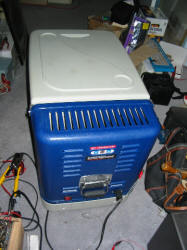
brackground
Some testing and
experimenting has been done to see if there was any way of improving the
efficiency of the fridge without making any major modifications. The restriction
of no major modification to the fridge prevented some avenues from being
investigated further.
test
ennironment
The testing was done with
the fridge set to 0 degrees, approx 80% full of drinks and inside a habitable
room. The room temperature was not controlled and impacted on absolute results
however adjacent testing ( ie tests either side of each other ) would not have
had any significant changes in environment so should be indicative for
comparison purposes. The duty cycle was measured by utilising a data logger
sensing the load current with a sample period of 10 seconds. Results were
monitored until 3 successive results were stabilised and then recorded.
observations/ modifications
1. The DC plug and cable were changed to utilise a standard ‘ARRID’ style plug.
This is very similar to the supplied plug/ socket combination however it
required that the DC socket on the fridge be replaced as the diameter of the
socket was fractionally smaller than the more common ARRID plug and it wouldn’t
fit.
2. Testing was then done to see if the ‘off’ time of the fridge could be
increased.
The compressor unit was
identified as a significant heat source near the fridge compartment. Various
forms of insulation were tried to see if they impacted on the ‘off’ time for the
fridge. No significant improvements were found however the insulation does
effect the cooling ( or ‘on’ time ). See the test data. The material used is
similar to ‘bubble wrap’ packaging material with a foil skin on the outsides. It
was chosen as being readily available and flexible enough to be manipulated into
place.
3. What may be worth investigating is if the insulation is acting as insulation
or as an air baffle.
4. Experimentation with the fan placement and number of fans produced some
significant improvements in the duty cycle of the compressor. The original fan
is located in the approximate centre of the motor compartment, blowing air
horizontally from the middle of the compartment through the condenser.
The problem with this location is that the hot air from the compressor, directly
below the fan, is blown through the condenser. By relocating the fan so that
cooler outside air is first blown over the condenser the efficiency of the
fridge is dramatically improved. As an indication the standard fridge, as
tested, had a duty cycle of ~59%, ( Test 1 ). With insulation and the relocated
fan the duty cycle is ~39% ( Test 6 ). The on time has been reduced by nearly
50%.
5. The fan location was not particularly critical however the proximity of the
fan intake to the outside casing was critical. Initial testing was done by
relocating the original fan to within 10-15mm of the outside of the compressor
compartment, then a flexible air baffle was added to seal the fan intake to the
outside of the compartment. The compressor run times improved from ~233 Seconds
( Test 4 ) to ~203 Seconds ( Test 5 ).
Results with a fan on the side or on the top of the compartment made minimal
difference to the duty cycle.
6. The final fan location was on the side of the compartment and fixed to the
outside of the case ie no air gap between the fan intake and the outside.
7. The modifications were undertaken to have minimal impact on the fridge to
allow for easy removal and restoration of the original configuration. As a
result the air intake for the fan Is not optimal. A significant amount of fan
noise is produced because of the restrictions to the inlet causing the air to be
sucked in the existing ventilation slits. And some mechanical vibrating noise as
a result of the fan being mounted onto the case.
8. Some experimentation was done with a 50degC thermal switch (mounted onto the
compressor) to switch the fans on/off. This appeared to have a slight
detrimental effect on the duty cycle.
9. Further investigation into switching the fan on/off with the compressor would
be warranted if only to reduce the noise and current consumption.
test results
Test 1
|
Standard |
| |
run 1 |
run 2 |
run 3 |
|
On time (sec) |
323 |
320 |
320 |
330 |
|
Off time (sec) |
223 |
220 |
230 |
220 |
|
Duty Cycle |
59% |
|
|
|
Test
2
|
With insulation only, no fans at all
|
| |
run 1 |
run 2 |
run 3 |
|
On time (sec) |
323 |
310 |
340 |
320 |
|
Off time (sec) |
187 |
190 |
180 |
190 |
|
Duty Cycle |
63% |
|
|
|
Test 3
|
With standard fan, insulation |
| |
run
1 |
run
2 |
run
3 |
|
On time (sec) |
343 |
340 |
360 |
330 |
|
Off time (sec) |
223 |
220 |
220 |
230 |
|
Duty Cycle |
61% |
|
|
|
Test 4
|
Insulation,
internal fan (near side of case,
sucking in cool air) |
| |
run 1 |
run 2 |
run 3 |
|
On time (sec) |
233 |
220 |
240 |
240 |
|
Off time (sec) |
250 |
250 |
250 |
250 |
|
Duty Cycle |
48% |
|
|
|
Test 5
|
Insulation,
internal fan (near side of case,
sucking in cool air) plus fan baffle |
| |
run 1 |
run 2 |
run 3 |
|
On time (sec) |
203 |
210 |
200 |
200 |
|
Off time (sec) |
250 |
250 |
250 |
250 |
|
Duty Cycle |
45% |
|
|
|
Test 6
|
Insulation,
small fan (80mm) bolted inside
of case, blowing across radiator |
| |
run 1 |
run 2 |
run 3 |
|
On time (sec) |
170 |
170 |
170 |
170 |
|
Off time (sec) |
270 |
270 |
270 |
270 |
|
Duty Cycle |
39% |
|
|
|
pictures
|
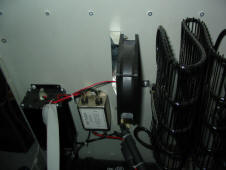
|
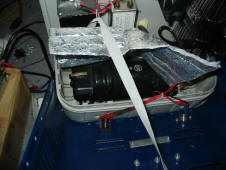 |
|
Original fan location |
Insulation-1 |
|
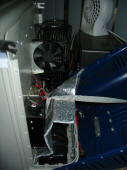
|
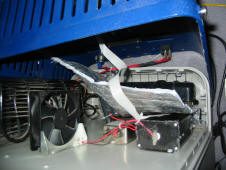 |
|
Insulation-2 |
Insulation-3 |
|
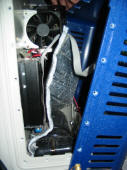
|
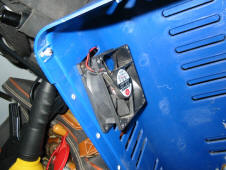 |
|
Insulation-4 |
New fan mounted on
inside of outer casing, condenser side of motor compartment near top. |
Thanks to Rod Egan
|